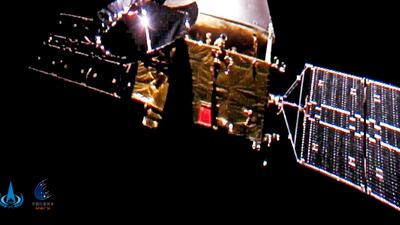A Chinese spacecraft entered orbit around Mars on Wednesday, a day after an orbiter from the United Arab Emirates did so and about a week before an American attempt to land another spacecraft on the surface of the Red Planet.
The uncrewed robotic probe initiated and completed a 15-minute burn of its thrusters, the China National Space Administration said, slowing the spacecraft to a speed at which it could be captured by the pull of Mars' gravity.
A spacecraft from the UAE swung into orbit around Mars on Tuesday – a triumph for the Arab world’s first interplanetary mission.
Ground controllers at the UAE space centre in Dubai rose to their feet and broke into applause when word came that the craft, called Amal, Arabic for hope, had reached the end of its seven-month, 483-million-kilometre journey and had begun circling the Red Planet, where it will gather data on Mars' atmosphere.
The challenging attempt to touch down on Mars is not expected for about three months. If all goes as planned, China will become only the second nation to do so successfully.
Tianwen-1 will circle and map Mars until the rover separates and attempts to land in May.
The rover will explore the Martian surface for 90 days, using a ground-penetrating radar to study its soil, and seek signs of ancient life and sub-surface water and ice.
Its name, the title of an ancient poem, means Quest for Heavenly Truth.
Landing a spacecraft on Mars soil is notoriously difficult, and China’s attempt will involve a parachute, back-firing rockets and airbags. Its proposed landing site is inside the normous, rock-strewn Utopia Planitia, where the US Viking 2 lander touched down in 1976.
The solar-powered rover – about the size of a golf cart – is expected to operate for about three months, and the orbiter for two years.
Only the US has successfully touched down on Mars – eight times beginning with the two Viking missions. A lander and rover are in operation today.
A US rover called Perseverance is aiming for a February 18 touchdown on Mars to also search for signs of ancient microscopic life and to collect rocks for return to Earth in the next decade.
The latest three Mars missions were all launched in July to take advantage of the planet's close alignment with Earth that occurs only every two years. The UAE's Hope orbiter began circling the planet on Tuesday to gather detailed data on Mars' atmosphere.
Six others were already operating around Mars: three US, two European and one Indian.
But many spacecraft did not make it. Smashed Russian and European spacecraft litter the Martian landscape, as does a failed US lander. About a dozen orbiters missed the mark.
Tianwen-1 is China’s second attempt to send a spacecraft to Mars. In 2011, a Chinese orbiter that was part of a Russian mission did not make it out of Earth’s orbit.
China’s secretive, military-linked space programme has progressed considerably since then. In December, its Chang’e 5 mission was the first to bring lunar rocks to Earth since the 1970s. China was also the first country to land a spacecraft on the little-explored far side of the Moon in 2019.

